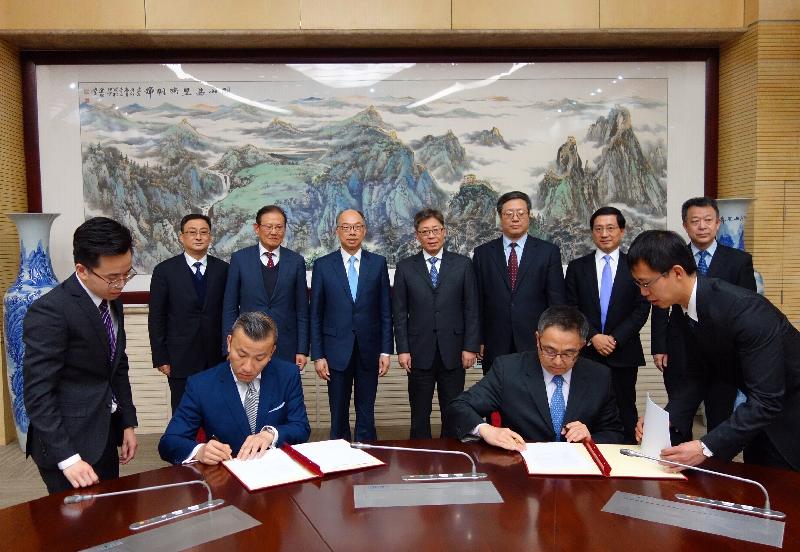Air services arrangements between Hong Kong and Mainland expanded (with photos)
The Transport and Housing Bureau and the Civil Aviation Administration of China (CAAC) signed a Memorandum of Understanding (MoU) in Beijing today (February 19) to expand the Air Services Arrangement between the Mainland and the Hong Kong Special Administrative Region (HKSAR).
The MoU was signed by the Deputy Secretary for Transport and Housing, Mr Wallace Lau, and the Deputy Director General of the Department of Transport of the CAAC, Mr Yu Biao. The signing was witnessed by the Secretary for Transport and Housing, Mr Frank Chan Fan, and the Deputy Administrator of the CAAC, Mr Wang Zhiqing.
The Outline Development Plan for the Guangdong-Hong Kong-Macao Greater Bay Area promulgated by the Central People's Government pointed out the need for further expansion of the domestic and international air services network of the Guangdong-Hong Kong-Macao Greater Bay Area, as well as the need for active expansion of intermodal code sharing service. In view of the commissioning of the Hong Kong Section of the Guangzhou-Shenzhen-Hong Kong Express Rail Link and the Hong Kong-Zhuhai-Macao Bridge last year, both sides agreed to expand the air-to-land intermodal arrangements between the Mainland and Hong Kong, which allow designated airlines of both sides to enter into code-sharing arrangements with operators of all types of land transport (including railway services, passenger vehicles and coaches) of all cities in the Mainland. The air-to-sea intermodal code-sharing arrangements were also opened up to sea transport between Hong Kong and the Pearl River Delta region.
Under the intermodal arrangements, operators of land and sea transport may share the codes of flights operated by designated airlines of both sides as an extension of flights, enabling both services (air-to-sea or air-to-land) to be available in the Global Distribution System. The new code-sharing arrangements are expected to bring much convenience to travellers taking different means of land and sea transport between the Mainland and Hong Kong International Airport. For instance, travellers may take the Express Rail Link using the same air ticket to travel to Guangzhou or Shenzhen and connect to railway services to different cities on the Mainland, which will assist in travel planning. Travellers may also use the same air ticket to reach the fast-developing cities in the Western Pearl River Delta (Western PRD), boosting the economic development in the Western PRD and the Bay Area. This essentially echoes with consolidating and enhancing Hong Kong's status as an international aviation hub as set out in the Outline Development Plan.
Regarding the initiatives in the Outline Development Plan concerning deepening management reform in low-altitude airspace, expediting the development of general aviation and steadily developing cross-boundary helicopter services, both sides also agreed to expand the scope of cross-boundary helicopter services to cover points in Guangdong Province to provide travellers with a high-end and convenient means of air transport. Air connectivity in the Bay Area will be enhanced, giving impetus to the diversified commercial and business activities in the Bay Area. The frequency of air services between Hong Kong and Shanghai Hongqiao International Airport will also be increased.
Mr Chan said that the MoU signed between the Mainland and the HKSAR is conducive to the implementation of the Outline Development Plan, in particular in consolidating and enhancing Hong Kong's status as an international aviation hub and strengthening its role as an aviation management training centre. The new MoU not only expands the air services and the intermodal arrangements between the Mainland and Hong Kong, but is also in line with the objective of the Outline Development Plan in terms of creating a word-class airport cluster by differential development and positive interaction amongst airports in the Bay Area. The arrangement has forged excellent conditions for better aviation infrastructure connectivity in the Bay Area.

